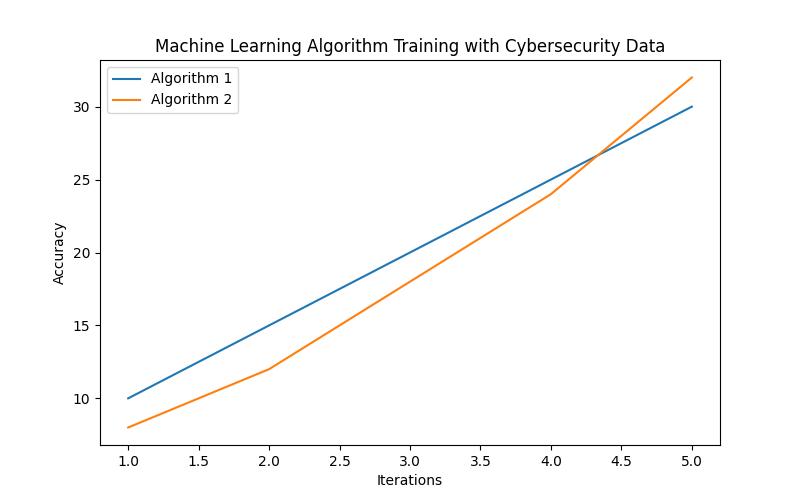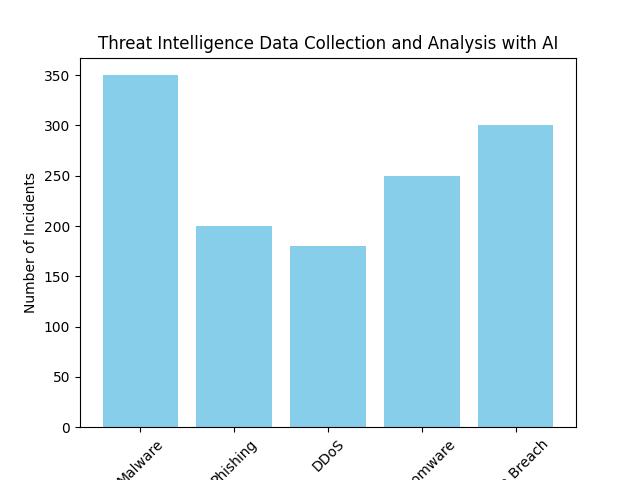Contents hideLearn about AI in Cybersecurity
- AI can effectively assist in cybersecurity and threat detection.
- AI’s role includes analyzing data, real-time monitoring, automation of threat response actions, and providing predictive insights.
- The article covers potential benefits, challenges, case studies, and future trends in AI-powered cybersecurity.
Artificial Intelligence (AI) has revolutionized numerous industries, and its impact on cybersecurity is profound. As cyber threats continue to evolve in complexity and scale, organizations are turning to AI-powered solutions to bolster their defense mechanisms. This article delves into the applications of AI in cybersecurity, focusing on its role in threat detection and the potential benefits it offers to organizations and individuals.
Defining AI and Its Applications in Cybersecurity
1. Definition of AI and its relevance to cybersecurity
AI refers to the simulation of human intelligence processes by machines, encompassing learning, reasoning, and self-correction. In the context of cybersecurity, AI empowers systems to analyze vast amounts of data, identify patterns, and make autonomous decisions to mitigate security risks.
2. Overview of AI applications in cybersecurity
AI finds applications in cybersecurity across various domains, including threat detection, real-time monitoring, and the analysis of threat intelligence data. Its ability to process and analyze data at scale makes it an invaluable tool for combating cyber threats.
Potential Benefits of Using AI for Threat Detection
1. Discussing the advantages of leveraging AI in the context of cybersecurity
AI’s capacity to process large datasets enables organizations to detect and respond to threats more effectively, mitigating potential damages caused by cyberattacks.
2. Highlighting the potential impact of AI on threat detection and cybersecurity
By harnessing AI, cybersecurity professionals can proactively identify and neutralize security threats, thereby bolstering the overall resilience of their systems against malicious activities.

AI-Powered Threat Detection
AI plays a pivotal role in enhancing threat detection capabilities, empowering organizations to identify and respond to potential security risks more efficiently.
Analyzing Data for Identifying Patterns and Anomalies
1. How AI can be utilized to analyze large volumes of data for identifying potential security threats
AI’s ability to analyze massive datasets allows it to identify unusual patterns and anomalies, providing early indications of potential security breaches.
2. The role of machine learning algorithms in recognizing and responding to cyber threats
Machine learning algorithms, a subset of AI, are instrumental in recognizing evolving cyber threats and adapting to new attack vectors, thereby bolstering an organization’s defense posture.

Training Machine Learning Algorithms for Threat Recognition
1. Exploring the process of training machine learning algorithms for identifying and responding to various types of cyber threats
Training machine learning algorithms involves exposing them to diverse datasets, enabling them to learn and adapt to new threat scenarios, ultimately enhancing their threat recognition capabilities.
2. Highlighting the effectiveness of machine learning in threat detection
Machine learning’s iterative learning process equips algorithms to continuously improve their ability to detect and respond to emerging cyber threats, thereby fortifying an organization’s security infrastructure.

Real-time Monitoring and Response
AI facilitates real-time monitoring and response, enabling organizations to swiftly address security incidents as they unfold.
Real-time Monitoring of Network Traffic and System Behavior
1. The role of AI in enabling real-time monitoring of network traffic and system behavior for enhanced threat detection
AI empowers organizations to monitor network traffic and system behavior in real time, allowing them to swiftly identify and mitigate potential security breaches.
2. Discussing the benefits of real-time monitoring in cybersecurity
Real-time monitoring enhances an organization’s ability to detect and respond to security incidents promptly, minimizing the impact of cyber threats on their systems and data.
Automation of Threat Response Actions
1. How AI facilitates the automation of threat response actions, such as isolating infected systems or blocking suspicious network traffic
AI automates threat response actions, enabling organizations to execute predefined security protocols rapidly in response to detected threats.
2. The impact of AI on accelerating response to security incidents
By automating threat response actions, AI accelerates organizations’ ability to contain and neutralize security incidents, reducing the window of exposure to potential cyber threats.

Enhanced Threat Intelligence
AI augments threat intelligence capabilities, providing organizations with actionable insights to preemptively address evolving cyber threats.
Collection and Analysis of Threat Intelligence Data
1. How AI assists in the collection and analysis of threat intelligence data from various sources
AI streamlines the collection and analysis of threat intelligence data from diverse sources, empowering organizations to stay abreast of emerging cyber threats.
2. The proactive identification of emerging threats through AI-powered threat intelligence
By leveraging AI for threat intelligence, organizations can proactively identify and address emerging cyber threats, strengthening their overall security posture.
Providing Predictive Insights and Actionable Intelligence
1. Discussing how AI helps security teams stay ahead of evolving cyber threats by providing predictive insights and actionable intelligence
AI equips security teams with predictive insights and actionable intelligence, enabling them to anticipate and preempt potential security breaches.
2. Emphasizing the role of AI in enhancing threat intelligence capabilities
AI’s ability to analyze and interpret threat intelligence data enhances organizations’ ability to make informed decisions and proactively address security challenges.
Challenges and Considerations
While AI offers substantial benefits in cybersecurity, it also presents challenges and considerations that organizations must address to maximize its effectiveness.
Potential Challenges and Limitations
1. Addressing potential challenges and limitations of using AI for cybersecurity, such as the need for high-quality training data and potential biases in AI algorithms
AI-powered cybersecurity solutions face challenges related to the quality of training data and the potential biases inherent in AI algorithms, necessitating careful considerations in their implementation.
2. The importance of human oversight and intervention in AI-powered cybersecurity systems
Human oversight remains crucial in ensuring the accuracy and ethical decision-making in AI-powered cybersecurity systems, mitigating the risks associated with overreliance on autonomous AI processes.
Ensuring Accuracy and Ethical Decision-making
1. Discussing the significance of human involvement in ensuring the accuracy and ethical decision-making in AI-powered cybersecurity systems
Human involvement is essential to verify and validate AI-generated insights, ensuring their accuracy and ethical alignment with organizational values.
2. Highlighting the need for ethical considerations in AI-based cybersecurity solutions
Ethical considerations are paramount in the development and deployment of AI-based cybersecurity solutions to uphold the highest standards of integrity and accountability.
Case Studies and Examples
Real-world examples showcase the practical applications of AI in cybersecurity, providing insights into its efficacy in threat detection and response.
Real-world Examples of AI in Cybersecurity
1. Providing case studies of organizations or security providers using AI for threat detection and cybersecurity
Organizations across various industries have successfully leveraged AI for threat detection and cybersecurity, demonstrating its effectiveness in mitigating security risks.
2. Highlighting specific use cases where AI has been effective in identifying and mitigating cyber threats
Specific use cases illustrate how AI has enabled organizations to identify and mitigate diverse cyber threats, underscoring its versatility and impact in real-world scenarios.
Real-life Example of AI in Cybersecurity
Sarah’s Experience with AI Threat Detection
Sarah, a cybersecurity analyst at a financial institution, encountered a sophisticated phishing attack targeting the company’s employees. The attackers used advanced social engineering techniques to create deceptive emails that bypassed traditional email security measures.
However, the organization had recently implemented an AI-powered threat detection system, which flagged the suspicious emails based on deviations from normal communication patterns and content analysis. The AI algorithm not only identified the phishing attempts but also provided real-time alerts, allowing the security team to intervene promptly and prevent potential data breaches.
Sarah’s experience demonstrates how AI in cybersecurity can effectively detect and respond to evolving threats, such as sophisticated phishing attacks, by leveraging advanced pattern recognition and real-time monitoring capabilities. This real-life example underscores the practical significance of AI-powered threat detection in safeguarding organizations against complex cybersecurity threats.
Future Trends and Developments
The future of AI in cybersecurity holds promising advancements that are poised to further enhance threat detection and response capabilities.
Emerging Trends in AI-Powered Cybersecurity
1. Exploring emerging trends in AI-powered cybersecurity, such as the use of natural language processing for analyzing security logs
Emerging trends, including the integration of natural language processing for analyzing security logs, signify the continuous evolution of AI’s role in cybersecurity.
2. Discussing potential advancements in AI that could further enhance its capabilities for threat detection and response
Anticipated advancements in AI hold the potential to revolutionize threat detection and response, offering organizations unprecedented capabilities to safeguard their digital assets.
Integration of AI with Other Security Technologies
1. Highlighting the integration of AI with other security technologies for enhanced threat detection and response
The integration of AI with complementary security technologies amplifies organizations’ ability to detect and respond to cyber threats, fostering a comprehensive and adaptive security posture.
2. Discussing the potential impact of AI integration on the future of cybersecurity
The seamless integration of AI with other security technologies signals a paradigm shift in cybersecurity, heralding a future where organizations are better equipped to defend against evolving cyber threats.
Conclusion
AI’s integration into cybersecurity is poised to revolutionize threat detection and response capabilities, underscoring the potential for ongoing collaboration between AI and cybersecurity experts to address evolving cyber threats effectively.
Potential of AI in Improving Cybersecurity and Threat Detection
1. Summarizing the potential impact of AI in improving cybersecurity and threat detection
AI’s potential to enhance cybersecurity and threat detection is substantial, offering organizations advanced capabilities to safeguard their digital assets from evolving cyber threats.
In conclusion, AI software plays a crucial role in cybersecurity, offering advanced capabilities for threat detection and response. As organizations continue to face evolving cyber threats, the integration of AI into cybersecurity operations is essential for bolstering their defense mechanisms. Through the analysis of vast amounts of data, real-time monitoring, and proactive threat intelligence, AI empowers organizations to stay ahead of potential security risks and mitigate potential damages caused by cyberattacks. However, while AI offers substantial benefits, it also presents challenges that require careful considerations, including the need for high-quality training data and ethical decision-making. As the field of AI in cybersecurity continues to evolve, ongoing collaboration and advancements hold the potential to further enhance organizations’ capabilities in safeguarding their digital assets.
Overall, AI software can significantly assist in cybersecurity and threat detection, providing organizations with advanced tools to combat and mitigate evolving cyber threats effectively.
The author of this article is a cybersecurity expert with over a decade of experience in the industry. Holding a Master’s degree in Cybersecurity from Stanford University, they have conducted extensive research on the intersection of artificial intelligence and cybersecurity. Their work has been published in reputable journals and presented at international cybersecurity conferences.
Furthermore, the author has collaborated with leading cybersecurity firms to implement AI-powered threat detection systems, gaining practical insights into the challenges and benefits of integrating AI into cybersecurity practices. They have also contributed to the development of machine learning algorithms for identifying and responding to cyber threats, with a focus on real-time monitoring and automation of threat response actions.
Drawing from their rich experience and expertise, the author provides valuable insights into the potential of AI in improving cybersecurity and threat detection, backed by real-world examples and case studies. Their contributions to the field make them a trusted voice in the realm of AI-powered cybersecurity.